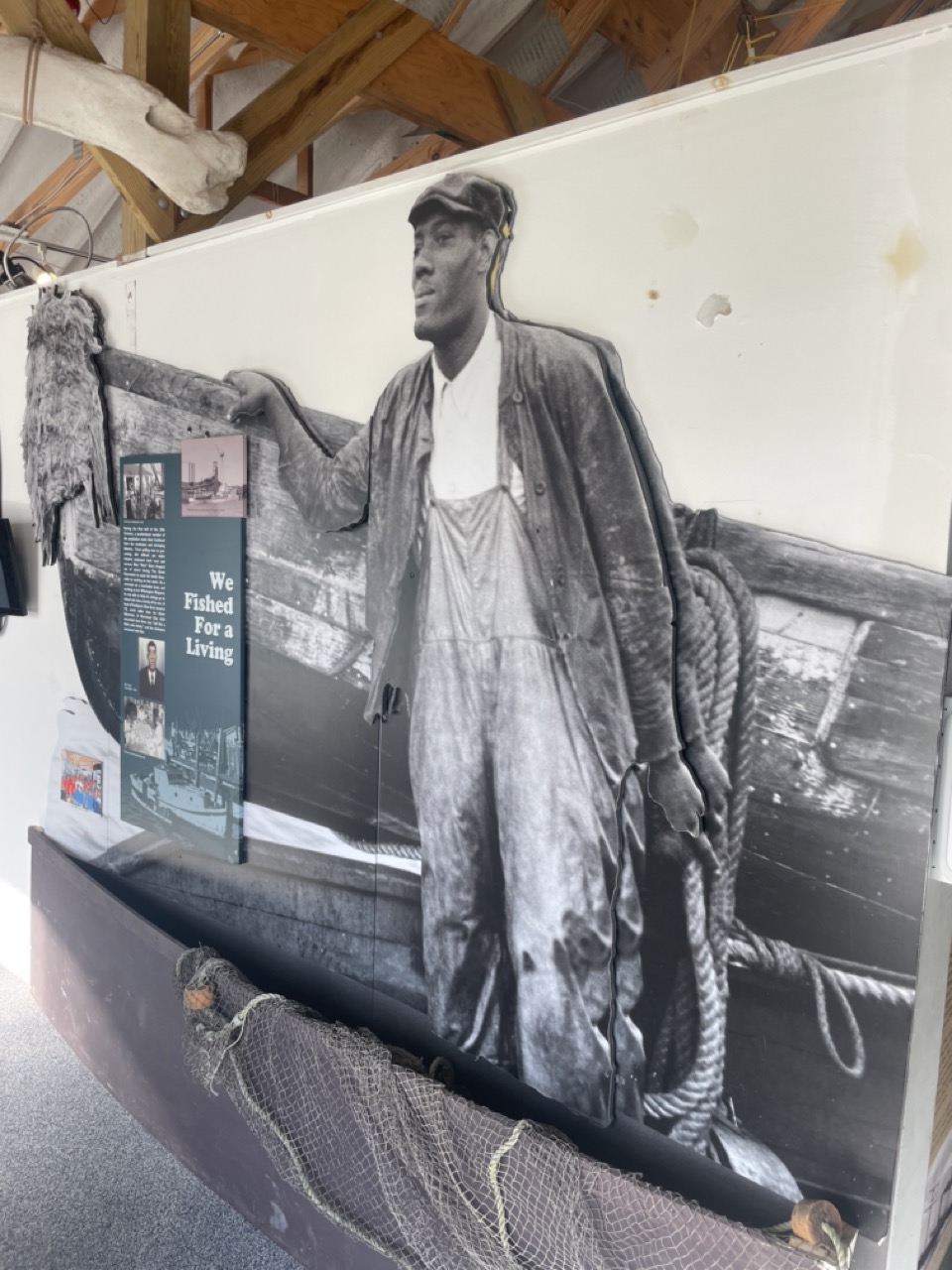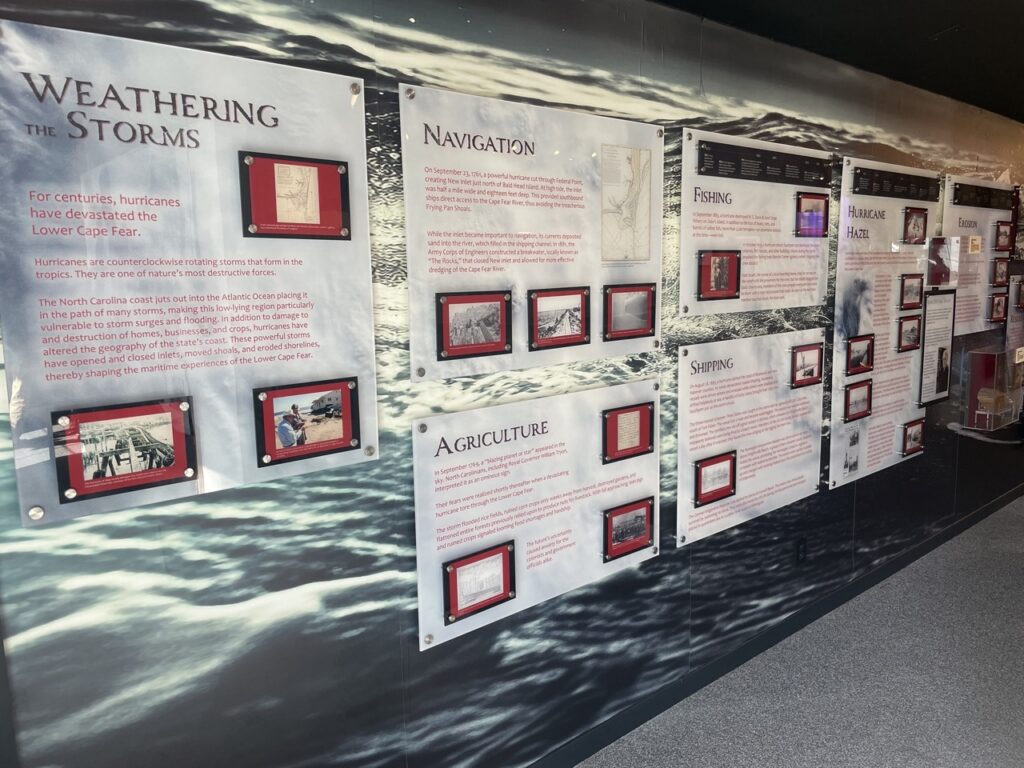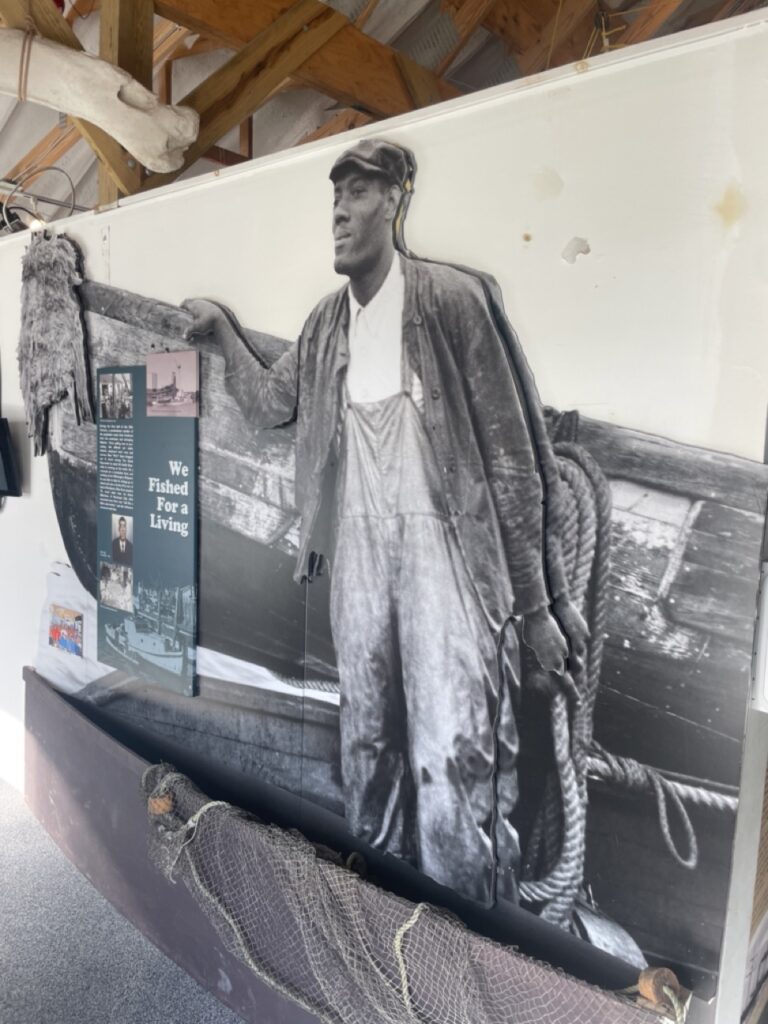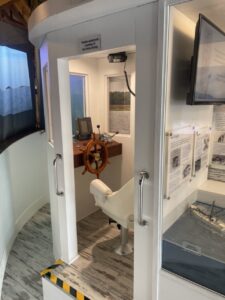Commercial Fishing Exhibit Opens at Maritime Museum

If you’re fishing for something to do this winter, stop in to the North Carolina Maritime Museum at Southport and check out the brand new exhibit on, what else, fishing in Southport! The crew has been hard at work since before the pandemic putting together an interactive and informative collection that highlights not just the role of the fishing industry in the lower Cape Fear, but also tying in the effect hurricanes have had on our region.
“It’s a pretty unique story to look at the fishing industry in the Southport and lower Cape Fear area, and that’s one of the things that we wanted to do. We wanted to tell these stories that we haven’t touched on in the past, that are key to understanding this area,” said Museum Manager John Moseley.
The display covers the area from around Brunswick Town down through Varnamtown. “When you start around Lockwoods Folly and go up to around Southport and the lower Cape Fear, you find out about all these various different industries that were here, the fish types that were being fished, and how fishing really dominated a lot of the life of this area,” Moseley said.
“The exhibit is going to talk about what were the kinds of fish were fished here, stuff like mullet, menhaden, even sturgeon, which most people might find surprising,” he explained. “And then you have the fish processing plants that were on the coast. You have the ships that were being used. So in the exhibit we’re going to talk about the fish, how they were being fished, how they were processed, how they’re canned and what was done with them, and all those local companies that were here.”
Have you ever heard of Nickel Town? Moseley found a newspaper story that talked about how the fish factories contributed to that being a nickname for Southport.
“There’s a great story of a gentleman from a newspaper, I don’t remember the paper, but coming down here to Southport and calling it Nickel Town,” Moseley said. “I’d never heard of that before and I read the article and apparently it was easier for the business owners to carry around buckets of nickels. So when you’re de-heading shrimp and doing these other things, you get paid a nickel per pound. They were hiring children, this is before the child labor laws, but you had children that were going in and they wanted to get ten cents so they could go to the candy store. The kids would do all this kind of work for a nickel. They could be de-heading shrimp, peeling shrimp, they could be gutting fish, they’d be doing a lot of stuff in these industries. The parents were doing this as well, and so the children were working alongside the parents and that was the family income. And they were getting paid in nickels. And so the stores were getting paid in nickels, going to the banks with bags of nickels, no dollar bills or anything, it’s all nickels. And so they called this place Nickel Town for a while.”
One of the jobs done for nickels was squeezing the juice from menhaden. Not the most appealing idea, but useful. “Menhaden was not a very tasty fish, but it was one that was used for the oils and it was also used or its scraps and it was turned into fertilizer for a lot of the crops that were grown in North Carolina. So the fish was very useful in many ways,” Moseley said. “You basically had a very oily fish that you could squeeze and get the oil out and use it for different things. There was something called Menhaden Milk. It was an oily pink substance that you could use for all different types of things.”

The fishing industry defined the community for a long time. “So in the exhibit we actually have some of the cases of some of the cans from the canning industry,” Moseley said. “Those were just collected over the years, and people donated them. You’d be surprised, a lot of people when these businesses closed, they would just take a can home with them because they worked there for so long.”
Fish stories aren’t limited to the factories though. You’ll learn about how during the World wars, local fishermen went submarine hunting.
“You’ve got WW I and WW II that kind of really also shift what’s going on,” Moseley said. “You have the Navy looking for shrimp boat captains and these menhaden boat captains and employing them to look for German U-Boats.

“They would fix up the fishing boats so they would look like war boats. You have these shrimp boats that are being armed. They’re removing all the arms and all the netting, they’re upgrading the engines and putting two fifty caliber machine guns on them and depth charges and they’re sending them out into the ocean to look for submarines.
“About 1944 they realize then German U-Boat menace isn’t there anymore, so they start bringing them back in and demilitarizing them. They keep some of them and they’re going out just to see if there’s anything suspicious going on, but now they’re throwing the shrimp nets back on the boats, so while they’re going out to hunt for subs they’re also trolling for shrimp. Then they come back in and say ‘Sorry, we didn’t find anything’ then pull up to the dock and offload all their shrimp, so they’re getting paid twice.”
Once again, this was a story that was sort of stumbled upon while putting this new exhibit together. “It was the craziest thing. These shrimp boats had been armed for all of this, and I didn’t even know that” Moseley said. “The whole reason I found this is that on the Southport Historical Society website, and in the State Port Pilot’s ‘The Way It Was book,’ was this photograph. And those are all shrimp boats that have been militarized. There was a Navy district based out of Fort Caswell that would keep track of this.”
Moseley said there was a fishing boom immediately following the war, no one had been fishing for a few years and stocks were high. “They had to be careful because if they caught too much the prices would drop,” he explained. “Nobody for two years had done any shrimping or any menhaden fishing or mullet. And so you read about these guys coming in with a banner day, the boats nearly about to sink because they’re filled with all these fish or shrimp or whatever they’re catching. After the war there was this boom with all this food, and then you’ve got nine years and then (Hurricane) Hazel hit and that just destroys the fishing fleet that was here and the fishing industry that was here.”
And that leads into the other half of the exhibit, which shows the changes, both natural and cultural, that hurricanes have brought to our area.
“So on one side we have the fishing exhibit and on the other side we have the hurricane exhibit to focus in on how hurricanes have changed the land and the way people live,” Moseley said. “So you’ve got starting in 1761 with the opening of New Inlet where the hurricane comes in and stays for quite some time and cuts a channel between the ocean and the Cape Fear.
“We talk about some of the other storms that happened here, the 1778 storm that sank the City of Houston, which is right off the Cape Fear and which we have artifacts from. There’s all kinds of stories, then you get to ’54 where you have this hurricane that wipes out the fishing fleet. And it’s all over the newspapers all over the country. Prior to that in 1944 there was another hurricane that came up the Cape Fear, followed the same track as Isaias and did about $30 million in damage which at that time was massive.
“These two exhibits will help us talk about how weather can influence business and the way people live.”
And that fits into the museum’s mission perfectly, Moseley said. “As a maritime museum, our job is to preserve what happened here, but is also to teach the people about what was going on here. And since we have so many people that are moving into the area, we want to be responsible and help them understand what it looked like 50, 60 or 100 years ago. And with this we can talk about hurricane season,” he said
“We have a lot people here who’ve never seen through a hurricane. We had a newcomers group come through and I asked how many had gone through a hurricane and only about half of them had, and most of those have been not really a hurricane,” he said.
“It gets people thinking. We can show the photographs of what happened in this area and the devastation, and it’s not to shock people, it’s to get them to think about ‘Hey, you know what, you’re living on the beach. You never know what’ll happen because of these storms.’ That’s what we want people to take away from the hurricane exhibit, how much these storms really change the geography of this area and how much they also change the way people are living in this area.”
“When people come to the museum, we don’t want them to just read about names, dates and places. We want them to understand the human experience, from the very beginnings with the American Indians here for thousands of years, to European contact, to colonial times, the Civil War, WW II, and how our society has changed through these experiences. We just collect those items that help us tell those stories,” Moseley said.
The new exhibit is open now, but will have a grand opening later this month. So stop on by, because if a historian learned new things putting this together, it’s sure to surprise you too.












Leave a Reply